Formal garden design offers a unique blend of structure and beauty, making it a delightful choice for those who appreciate symmetry and order in their outdoor spaces. Whether you’re looking to create a serene retreat or a lively gathering spot, these gardens combine classic elements with personal touches to enhance your landscape. Get ready to explore a variety of styles and inspiration that can help you cultivate a garden that feels both elegant and inviting.
Seasonal Blooms: Planning for Year-Round Beauty
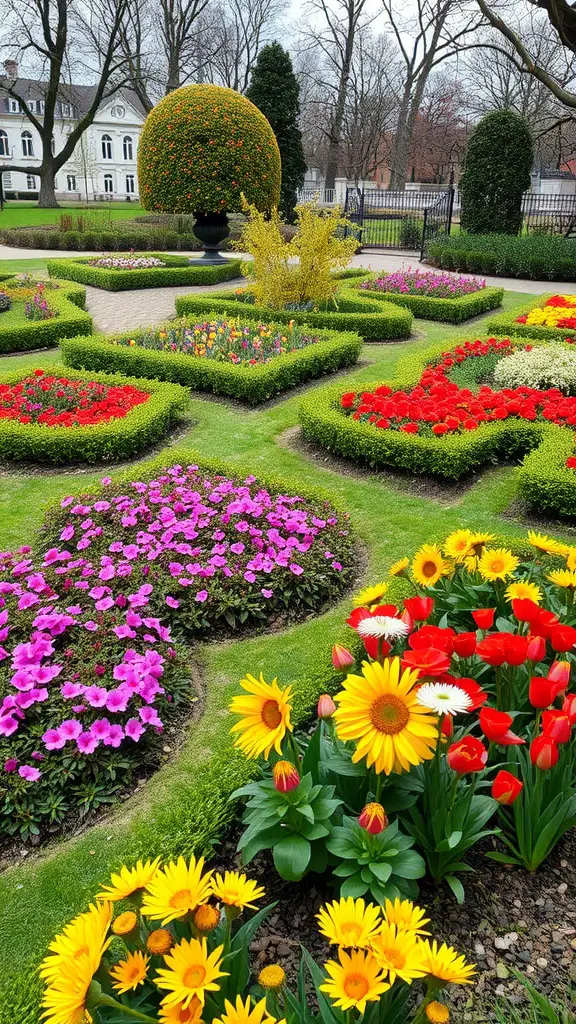
Creating a garden that looks beautiful all year long is a fun challenge. The image showcases a delightful formal garden filled with vibrant flowers and well-manicured hedges. You can see a variety of colors, with bright yellows, reds, and purples standing out beautifully against the green background.
In planning for seasonal blooms, it helps to choose plants that flower at different times of the year. The mix of tulips, daisies, and other blossoms in the image hints at this strategy. For spring, consider planting tulips and pansies, which bring life right after the winter chill.
As summer approaches, you might want to introduce sunflowers and other hardy flowers that thrive in the heat. The arrangement in the image highlights how different colors can complement each other, creating a lively and inviting atmosphere.
In fall, consider adding plants that offer rich colors, such as chrysanthemums and asters. These will extend the beauty of your garden into the cooler months. Finally, evergreen plants and decorative elements, like the rounded topiary shown here, can add structure during winter.
By mixing seasonal blooms, you can enjoy a garden that evolves throughout the year. Each season will bring its own charm, making your outdoor space a joy to visit any time.
The Role of Walkways in Formal Design
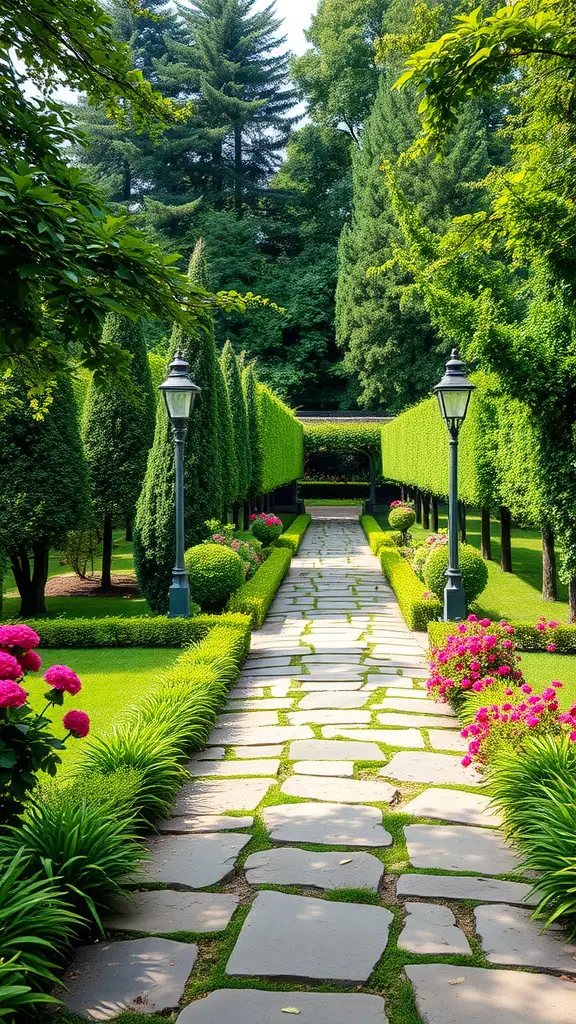
Walkways are an essential element in formal garden design. They guide visitors through the garden, creating a sense of direction and purpose. In the image, the well-defined stone path leads the eye forward, inviting exploration.
The layout of the walkways often reflects symmetry and balance, key characteristics of formal gardens. Notice how the path is flanked by neatly trimmed hedges and vibrant flowers. This combination not only enhances the visual appeal but also establishes a structured environment.
Lighting plays a significant role too, as seen with the charming lampposts along the path. They not only illuminate the way in the evening but also add an element of charm and sophistication to the garden’s design.
Moreover, walkways can influence the overall experience of a garden. A well-placed path can create a journey, leading visitors to hidden nooks or spectacular views, enhancing the interaction with the landscape.
Geometric Patterns: A Design Staple
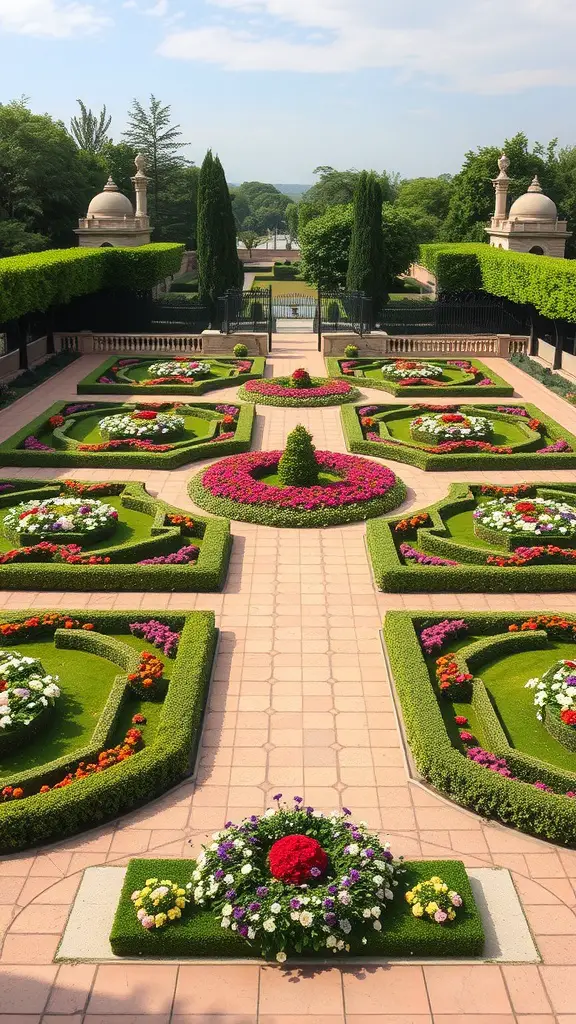
Geometric patterns play a vital role in formal garden design, creating a sense of order and symmetry that is pleasing to the eye. The image showcases a beautifully arranged garden that exemplifies this concept perfectly.
In the center, a circular formation surrounded by vibrant flowers draws immediate attention. This focal point is enhanced by the surrounding geometric shapes, each neatly trimmed and meticulously planned. The box hedges provide a clean border that adds to the structured feel of the space.
Each section of the garden is distinct yet contributes to a cohesive overall design. The careful arrangement of greenery and blooms invites visitors to explore further. The combination of colors—from the rich reds and whites to the subtle purples—adds depth while maintaining harmony.
This type of layout is not just visually appealing but also functional. It allows for easy navigation and can serve various purposes, whether it’s a quiet retreat or a space for social gatherings. Geometric patterns in gardens reflect a thoughtful approach to design, marrying both beauty and practicality.
Timeless Symmetry in Garden Layouts

Symmetry in garden design creates a sense of balance and harmony. In the image, you can see a well-structured formal garden that embodies this concept beautifully. The neatly trimmed hedges and circular topiaries are arranged in a way that draws the eye toward the center, making it a captivating focal point.
Notice the tall cypress trees that frame the path. Their vertical lines contrast with the rounded shapes of the bushes. This interplay of shapes adds depth and interest to the layout. Each element is carefully positioned to maintain the garden’s equilibrium, showcasing the art of formal landscaping.
The paved walkway leads through the garden, inviting visitors to explore. The shadows cast by the greenery on the path enhance the visual appeal. It’s almost like nature is painting its own artwork with light and shadow.
Overall, this garden is a clear example of how timeless symmetry can elevate a space. Whether you’re planning a garden of your own or just appreciating the beauty of nature, these balanced designs inspire tranquility and a sense of order.
Classical Elements: Fountains and Statues
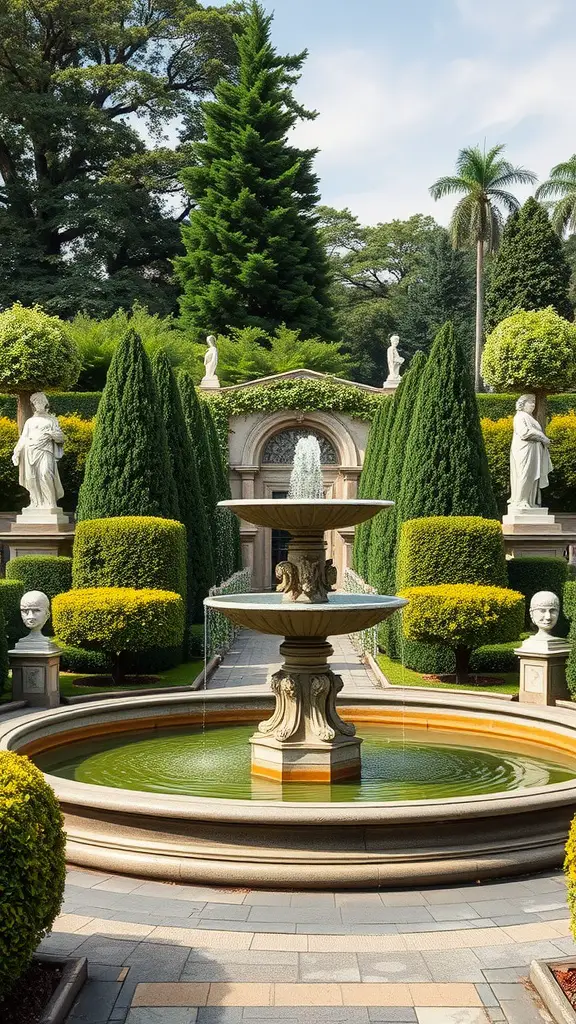
When you think of a formal garden, the image of elegant fountains and classic statues often comes to mind. This garden, with its beautifully arranged greenery and serene water features, perfectly embodies that vision. The centerpiece is a stunning fountain that captures the essence of classical design.
The fountain’s tiered structure allows water to flow gracefully, creating a sense of tranquility. The gentle sound of water cascading down provides a soothing backdrop to the lush surroundings. It invites visitors to pause and enjoy the moment.
Flanking the fountain, you can see statues that add character and history to the garden. These sculptures not only enhance the visual appeal but also tell stories of art and culture. They serve as a reminder of the time-honored traditions that influence garden design.
Surrounding the fountain, neatly trimmed hedges and vibrant topiaries create a sense of order and harmony. This design element emphasizes the garden’s formal nature while providing a lush green backdrop against the statues and fountain.
Color Schemes: Bold vs. Subtle

When it comes to formal garden design, color schemes play a crucial role. The vibrant blooms in the image showcase a bold approach to color. Bright yellows, fiery oranges, striking pinks, and deep reds create an energetic vibe that can instantly uplift any garden space.
Choosing a bold palette like this can be a fun way to express personality. These colors can draw attention, making the garden a focal point. However, it’s important to balance these hues through thoughtful placement. Pairing bold flowers with greenery or softer colors can help ease the visual intensity.
On the other hand, subtle color schemes offer a calm and elegant feel. They can create a serene atmosphere that encourages relaxation. Using pastel shades or muted tones allows for a more understated beauty. This approach can be especially appealing in a formal garden, where symmetry and balance are key.
Ultimately, the choice between bold and subtle colors depends on your vision for your garden. Whether you want a lively space filled with energy or a tranquil retreat, the right color scheme can help you achieve that dream.
Creating Privacy with Hedges and Walls
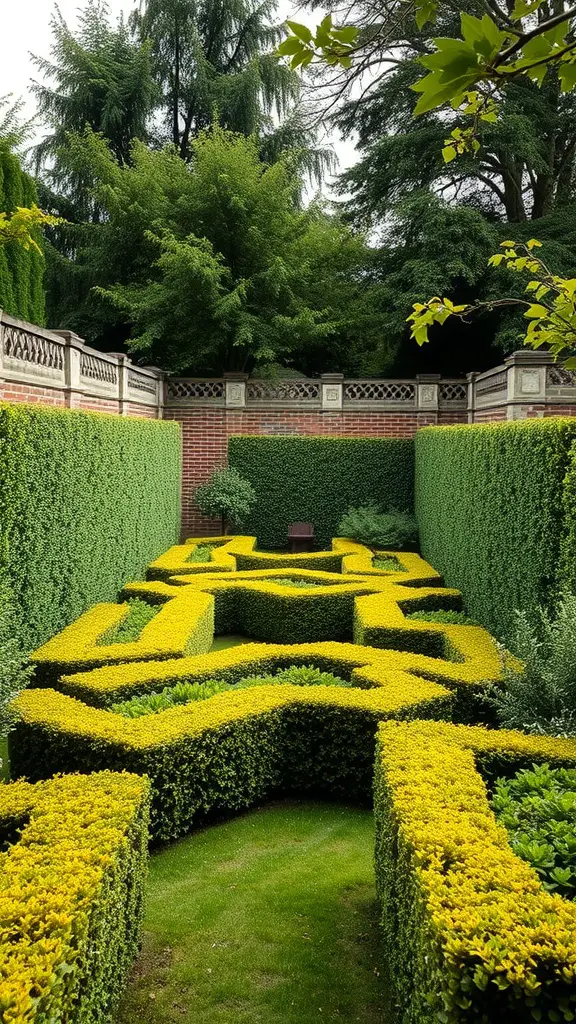
In garden design, creating a sense of privacy can transform an outdoor space into a personal retreat. The image above showcases a beautifully manicured garden bordered by lush hedges and walls, providing both aesthetic appeal and seclusion.
The vibrant yellow hedges create an inviting path that draws the eye while offering a clear boundary. This layered design not only enhances the structure of the garden but also shields it from outside views, making it a cozy nook for relaxation or entertainment.
Adding walls or trellises can further enhance privacy. In this setting, the brick wall complements the greenery, adding a touch of elegance. The combination of natural and built elements encourages a harmonious balance.
For those looking to achieve similar results, consider incorporating a mix of tall hedges and sturdy walls in your garden. This approach effectively blocks noise and visual distractions, allowing you to enjoy your outdoor space in peace.
Lighting Design: Enhancing Nighttime Ambiance
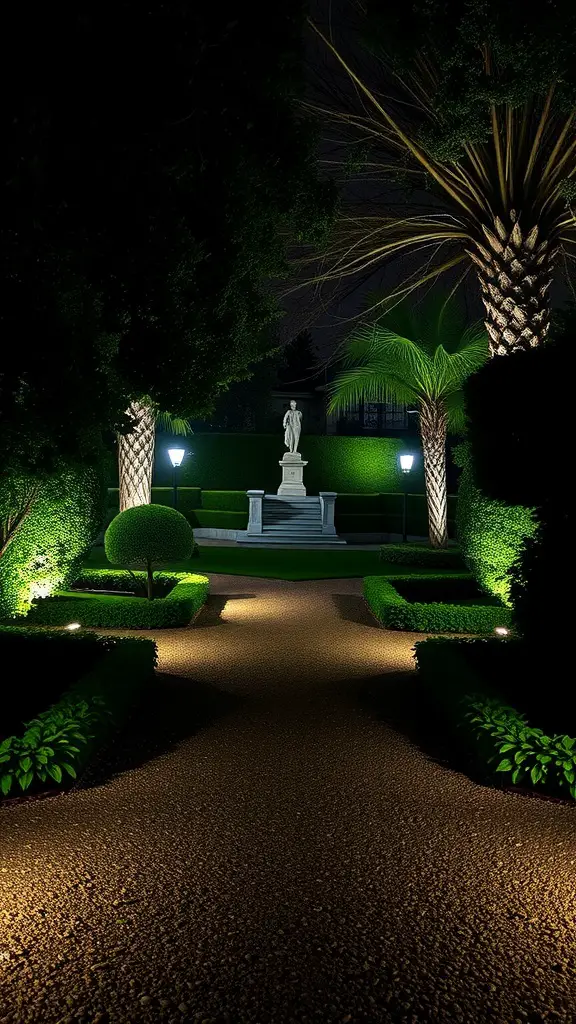
In a formal garden, lighting plays a crucial role in setting the mood after the sun goes down. The image showcases a beautifully illuminated garden path, guided by soft lights that highlight the neatly trimmed hedges and elegant palm trees. The lighting not only makes the space inviting but also creates a serene atmosphere.
The pathway leads toward a central statue, which is illuminated to draw the eye. This focal point adds character and charm to the garden, making it a lovely spot to unwind at night. Each light source is strategically placed to enhance the garden’s features, while also ensuring safety for evening strolls.
Choosing the right fixtures can further elevate the garden’s aesthetic. Consider using lanterns or spotlights that complement the garden’s style. The goal is to create an enchanting experience that encourages relaxation and enjoyment under the stars. With thoughtful lighting design, a formal garden transforms into a magical retreat as night falls.
Garden Furniture: Elegance and Comfort Combined
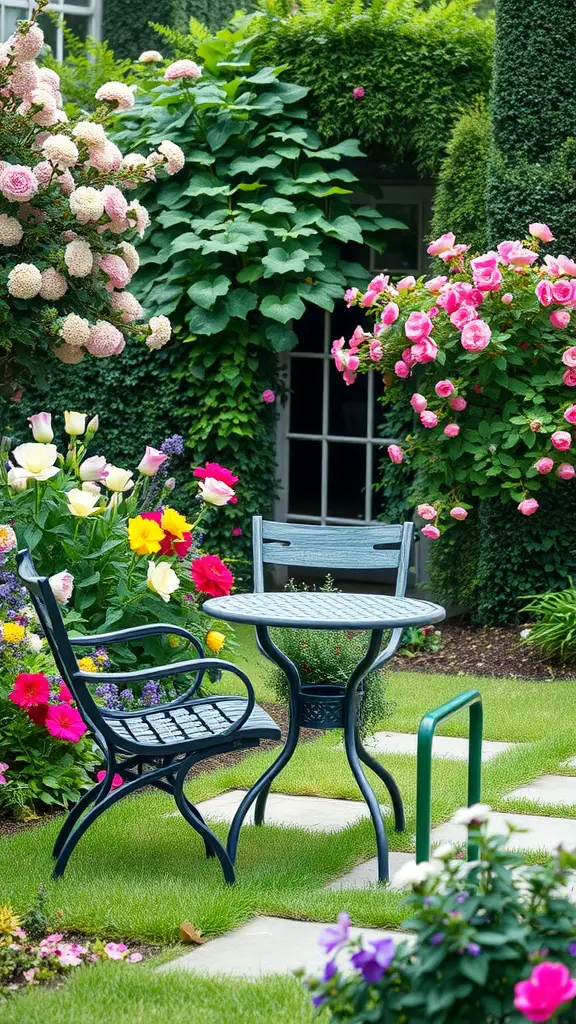
In the heart of every formal garden, you’ll find a special spot to relax and enjoy the beauty around you. The image beautifully illustrates how garden furniture can blend elegance with comfort.
The charming table and chairs invite you to sit down, sip a drink, and soak in the vibrant colors of the flowers. Surrounded by lush greenery and blooming roses, this setting is perfect for a casual chat or a quiet moment with a book.
Choosing the right furniture can enhance your outdoor space. Look for pieces that not only fit your style but also provide comfort. The design of the chairs here offers support while allowing you to enjoy your surroundings. The round table is ideal for intimate gatherings or a peaceful breakfast in the garden.
As you think about your garden layout, consider placing furniture where it can be the center of attention or a cozy retreat. With the right arrangement, you can transform your garden into a delightful escape that combines the beauty of nature with the comfort of home.
Vertical Gardens: Maximizing Space Elegantly
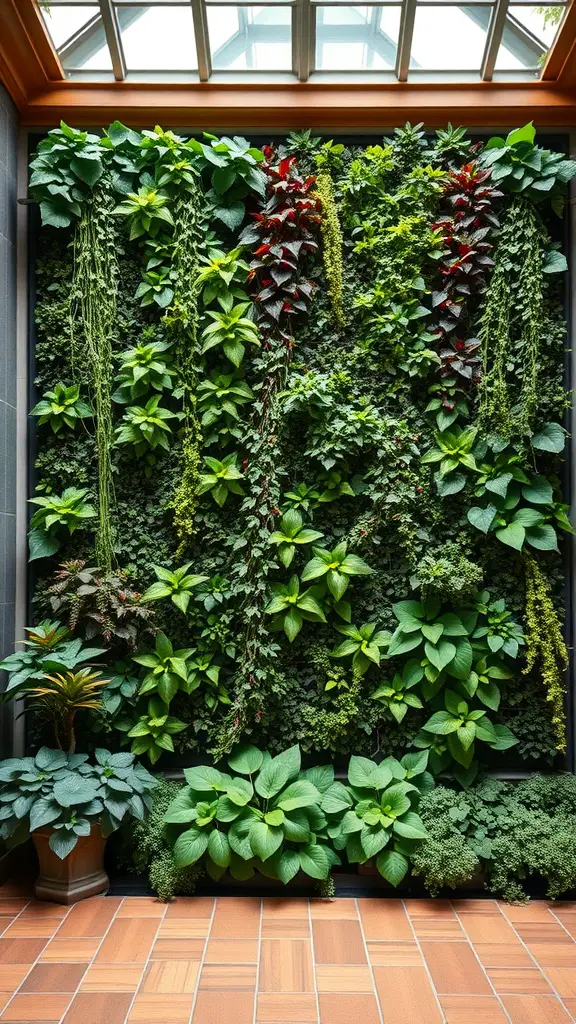
Vertical gardens are a fantastic way to bring greenery into smaller spaces. This image showcases a beautifully designed vertical garden that combines various plants in a compact area, making it an ideal choice for urban living. The lush foliage and vibrant colors add a refreshing touch to any indoor or outdoor setting.
In this garden, you can see a mix of climbing plants and trailing vines, which create a layered effect. The diversity of textures and shades of green enhances the visual appeal. This not only maximizes space but also creates a serene atmosphere that can be enjoyed from anywhere in the room.
Moreover, vertical gardens offer numerous benefits. They can improve air quality, provide insulation, and even reduce noise levels. With the right care, these gardens can thrive for years, making them a sustainable choice for garden design.
Incorporating Water Features for Serenity
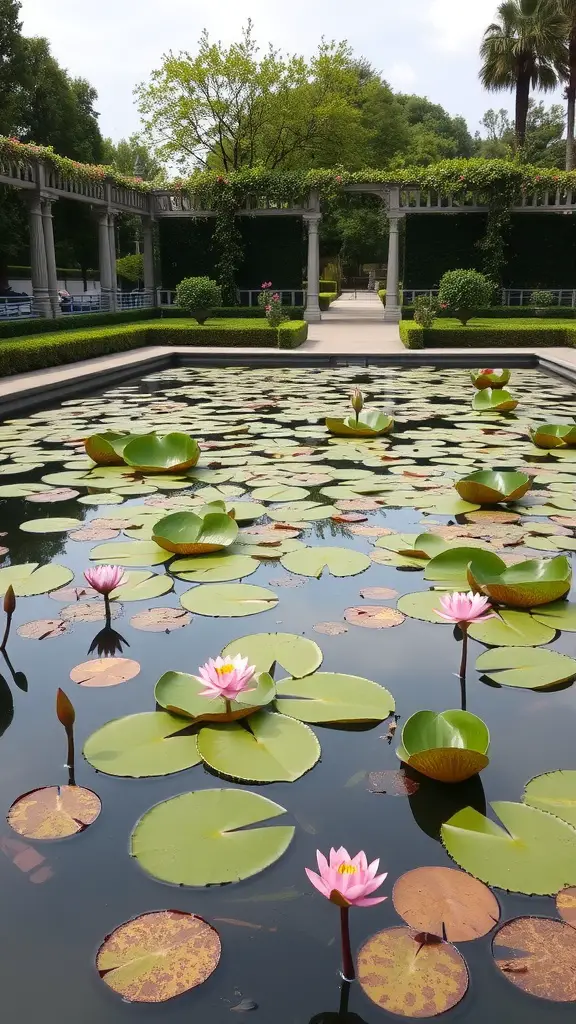
Water features in a formal garden can truly enhance the tranquil vibe. In the image, we see a lovely pond adorned with lily pads and delicate pink flowers. These elements add beauty and a sense of calm to the space.
The reflections on the water’s surface create a peaceful ambiance. This can make a garden feel more inviting and serene, encouraging visitors to relax and unwind. Surrounding greenery and structured paths further enhance the overall charm.
Including water elements like ponds or fountains can attract various wildlife, such as birds and butterflies, which add life to the garden. The gentle sound of flowing water can also be soothing, making it a perfect spot for meditation or quiet reflection.
Overall, adding such features not only beautifies the garden but also serves to create a serene escape from the hustle of daily life. This approach is simple yet effective for anyone looking to elevate their garden design.
Edible Plants: Integrating Functionality with Aesthetics
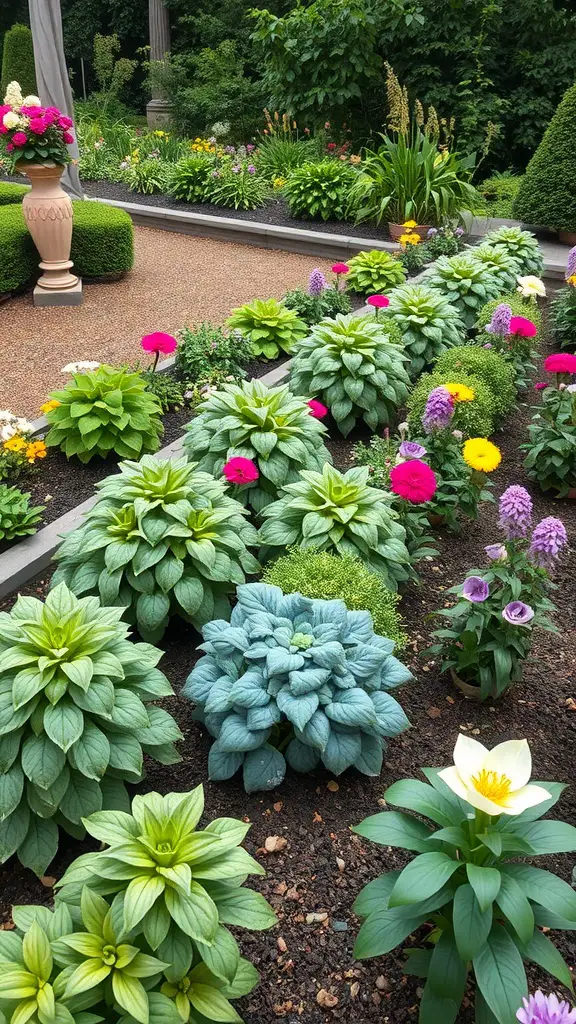
Incorporating edible plants into a formal garden design is a delightful way to blend beauty with practicality. The image showcases a well-maintained garden filled with vibrant flowers and lush greenery, creating a striking visual appeal. However, many plants here can also serve a culinary purpose.
For instance, consider planting herbs like basil or thyme alongside decorative flowers. These herbs not only add texture and fragrance but also provide fresh ingredients for your meals. The colorful blooms, such as the pink and yellow flowers in the garden, can coexist with leafy greens, making the space both stunning and functional.
Another idea is to integrate colorful vegetables like Swiss chard or kale into the floral arrangements. Their unique leaf shapes and vibrant hues can enhance the aesthetic while offering nutritious options for your kitchen. This thoughtful mix allows you to enjoy a beautiful view and the satisfaction of growing your own food.
Remember, maintaining this balance requires planning. Ensure that the edible plants receive enough sunlight and are well-placed among the ornamental varieties. This way, you create a harmonious garden that’s as enjoyable for the eyes as it is for the palate.
Plant Selection: Choosing the Right Species
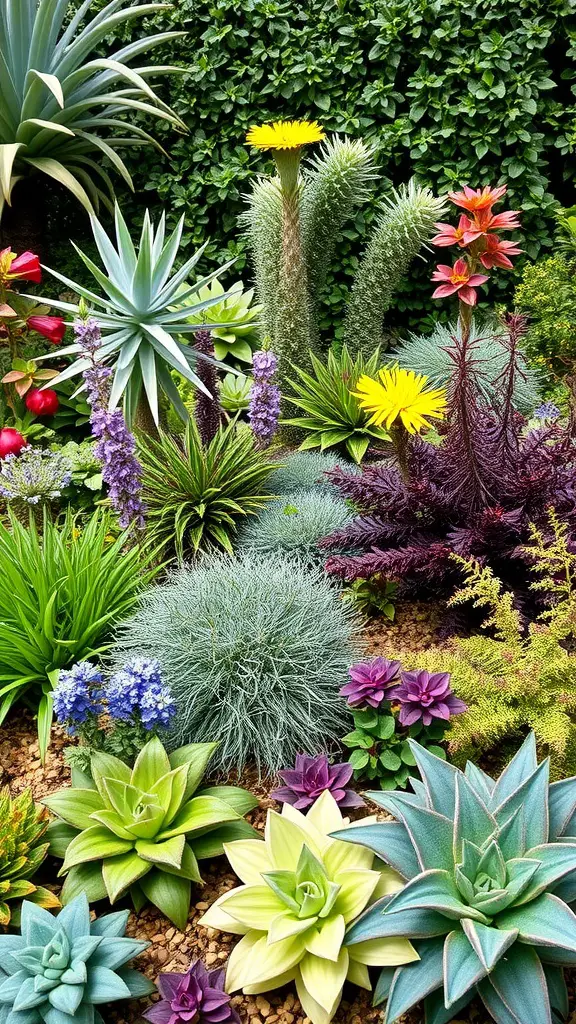
When designing a formal garden, plant selection is crucial. The image showcases a vibrant mix of various plants. This variety helps create visual interest and structure in the garden.
In the foreground, you can see beautiful succulents with distinct colors and shapes. These are not just attractive; they are also low-maintenance, making them ideal for busy gardeners. Pair them with taller plants, like the flowering cacti in the background, to create layers.
Notice the pops of color from the flowers and leaves. Incorporating plants with varied textures and hues can make your garden more dynamic. The purple and yellow flowers add a cheerful touch, while the green foliage provides a calming backdrop.
When choosing plants, consider your climate and soil conditions. Some plants thrive in dry conditions, while others need more moisture. Researching the needs of each species will help ensure they flourish together.
Lastly, think about the seasonal changes. Selecting plants that bloom at different times can keep your garden looking lively throughout the year. A well-thought-out selection will create a garden that both you and your guests can enjoy.
Topiary Art: Shaping Nature
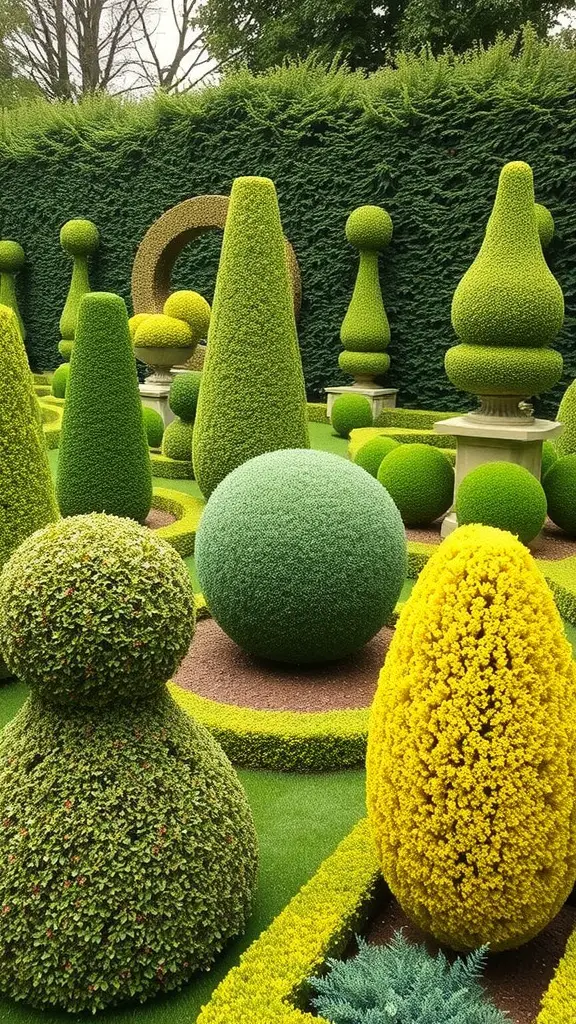
Topiary is a delightful way to blend art with nature. In the image, we see an array of carefully shaped bushes and plants that create a playful, yet elegant scene. The vibrant greens and the striking yellow elements add a lively touch to the garden design.
Each form in the garden tells a story. From the tall, slender cones to the round, soft shapes, these designs invite curiosity. They are not just plants; they are sculptures that enhance the natural beauty of the garden.
Maintaining topiary art requires skill and patience. Regular trimming is essential to keep the shapes defined. Gardeners often use special tools to achieve the precise cuts necessary for these intricate designs.
Incorporating topiary into a garden space can create focal points that draw the eye. They can define pathways, create intimate spaces, or even serve as whimsical accents. The image showcases how varying heights and shapes can play together harmoniously.
If you’re looking to add a touch of topiary art to your garden, start small. A few well-placed shapes can transform your outdoor space into a charming retreat. As your skills grow, so can your collection of unique forms!
Garden Arbors and Trellises: Adding Depth
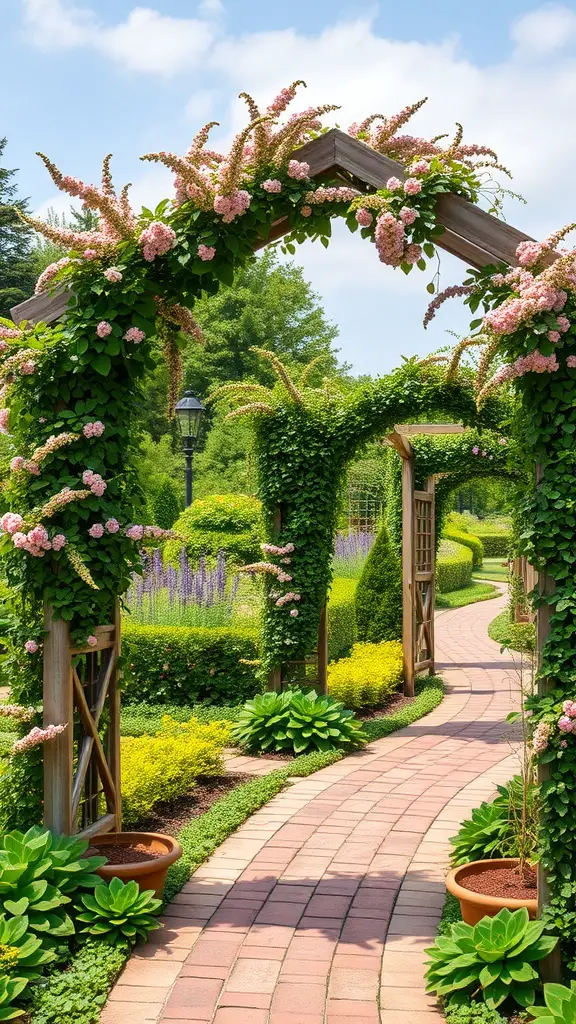
Garden arbors and trellises serve as beautiful features in any outdoor space. The image perfectly illustrates this, showcasing a charming path lined with vibrant greenery and blossoming flowers. The wooden arbors create inviting passageways that draw you deeper into the garden.
As you stroll under the delicate blooms, it’s easy to appreciate how arbors provide structure and frame views. They can transform a simple path into an enchanting journey. The lush vines cascading over the trellises add texture and color, enhancing the overall aesthetic.
These elements also play a practical role. They can support climbing plants, creating vertical gardens that maximize space. In this way, arbors and trellises not only look lovely but also help in cultivating a diverse range of plants, contributing to a more dynamic garden environment.
Therapeutic Benefits of Formal Gardens

Formal gardens offer a serene escape from the hustle and bustle of everyday life. The image captures a cozy seating area surrounded by neatly trimmed greenery, inviting visitors to sit back and unwind. This setting embodies the essence of a therapeutic garden, where the design promotes relaxation and mindfulness.
The clean lines of the patio, combined with the lush greenery and vibrant flowers, create a balanced environment. Nature has a way of healing, and gardens like this provide a perfect backdrop for stress relief. Spending time here can help clear the mind and rejuvenate the spirit.
Sitting in this tranquil space, one can appreciate the beauty of nature. The structured layout of the garden not only looks appealing but also encourages visitors to slow down and enjoy their surroundings. Whether reading a book or sipping tea, such moments can significantly enhance mental well-being.
Moreover, the act of tending to a formal garden can be therapeutic. Gardening encourages physical activity and fosters a connection with the earth. The rhythmic motions of planting and pruning can bring a sense of fulfillment and peace.
Pathway Materials: Stone, Gravel, and More
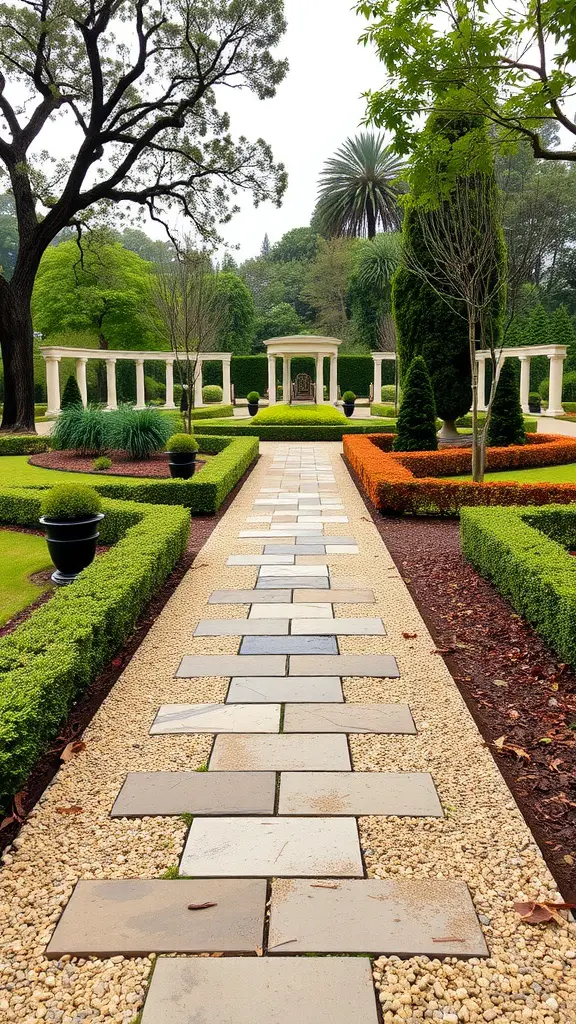
When designing a formal garden, the pathway is key to guiding visitors through your green oasis. The image showcases a beautifully laid pathway, blending stone slabs with gravel. This design not only looks neat but also provides a practical solution for foot traffic.
Using stone slabs creates a structured feel, making the pathway a focal point in the garden. They can be placed in various patterns to enhance visual interest. The gravel surrounding the stones adds texture and helps with drainage, which is essential for maintaining a healthy garden.
In addition to stone and gravel, consider other materials like bricks or tiles. Each option can offer a unique character to your garden. For instance, bricks provide a rustic charm, while tiles can lend a modern touch. Mixing materials can also add depth and variety to the design.
Remember, the choice of pathway material should complement the surrounding plants and garden elements. A well-chosen pathway not only enhances the beauty of the garden but also creates a welcoming atmosphere for guests. So, think carefully about what materials will best suit your space!
Sculptural Planting Techniques
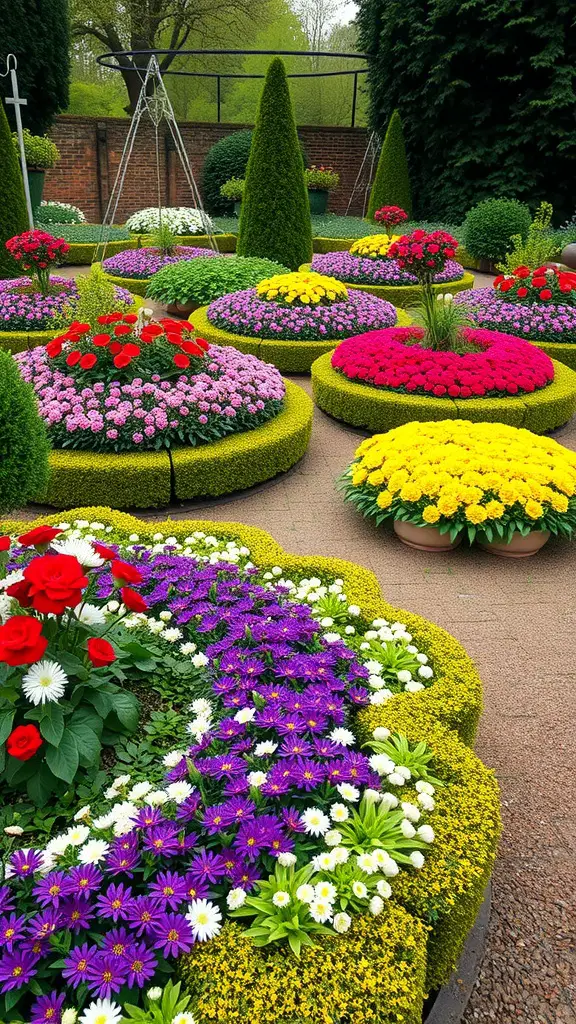
Sculptural planting techniques add a unique flair to garden design, and this image beautifully illustrates that concept. The garden is designed with circular floral arrangements, making a bold statement with its vibrant colors. Each section features a blend of flowers and greenery, creating a layered effect that draws the eye.
The use of rounded shapes and varying heights of plants gives the garden a sculptural quality. Notice how the bright red and yellow flowers stand out against the lush green borders. This contrast not only enhances the visual appeal but also emphasizes the importance of color selection in garden design.
Incorporating different plant sizes and shapes can create depth and texture. The tall, pointed plants provide height, while the low-growing flowers fill in the space, creating a harmonious balance. This layering technique is key in achieving a sculptural look.
Furthermore, this garden showcases how symmetry can play a significant role. The evenly spaced circular flower beds create a sense of order, making the entire space feel organized and inviting. Such design elements can transform any outdoor space into a visually enticing area.
Seasonal Decorations: Bringing Festivity to Gardens
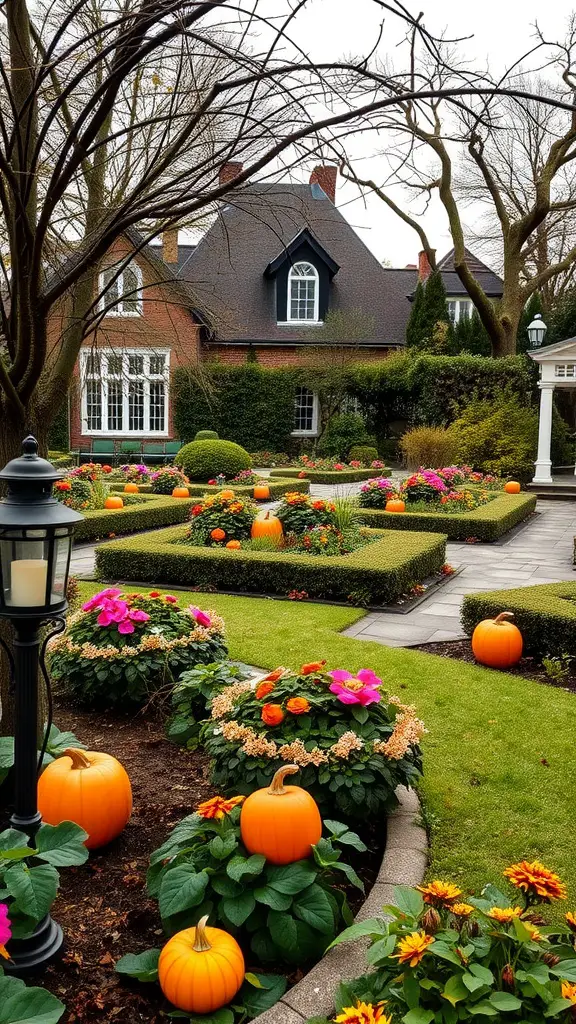
Seasonal decorations can truly transform a garden, creating a vibrant atmosphere that reflects the time of year. In this lovely garden, pumpkins and colorful flowers are beautifully arranged, showcasing the essence of fall. The bright orange pumpkins stand out against the green foliage, adding a cheerful touch.
The design of the garden complements the seasonal theme. Neatly trimmed hedges frame the space, while flowers in shades of pink and yellow bring life to the areas around the pumpkins. This combination not only enhances the visual appeal but also makes it inviting for anyone passing by.
Incorporating seasonal elements like pumpkins not only highlights the harvest season but also sparks joy. As autumn approaches, think about how you can use similar decorations to bring warmth and festivity to your own garden. Whether it’s adding a few pumpkins or planting seasonal flowers, small touches can make a big difference.
Garden Scent: Creating an Aromatic Experience
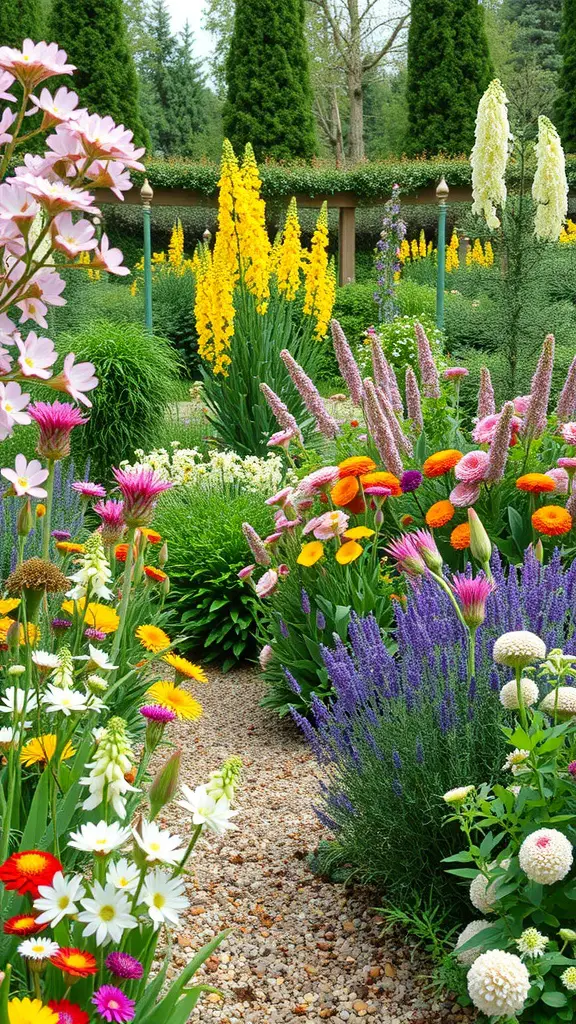
Imagine stepping into a garden bursting with color and fragrance. This garden showcases a lovely mix of flowers, each contributing to a delightful scent. The pathway invites you to explore the different blooms, making it a sensory journey.
As you walk through the garden, the bright yellow flowers stand tall amongst the lush greenery. Their vibrant hue draws your eye and their scent adds a cheerful note to the air. Nearby, the delicate lavender releases a calming aroma that contrasts beautifully with the more vivid flowers.
The mix of daisies, orange blooms, and pink petals creates a tapestry of colors that not only pleases the eyes but also teases the senses. Consider adding herbs like basil or mint to your garden; their fresh scents can enhance the aromatic experience even further.
Incorporating aromatic plants isn’t just about fragrance. These scents can evoke memories and emotions, making your garden a place of comfort. It’s about creating an atmosphere where you can unwind and enjoy nature’s beauty.
Drought-Tolerant Plants for Sustainable Gardens
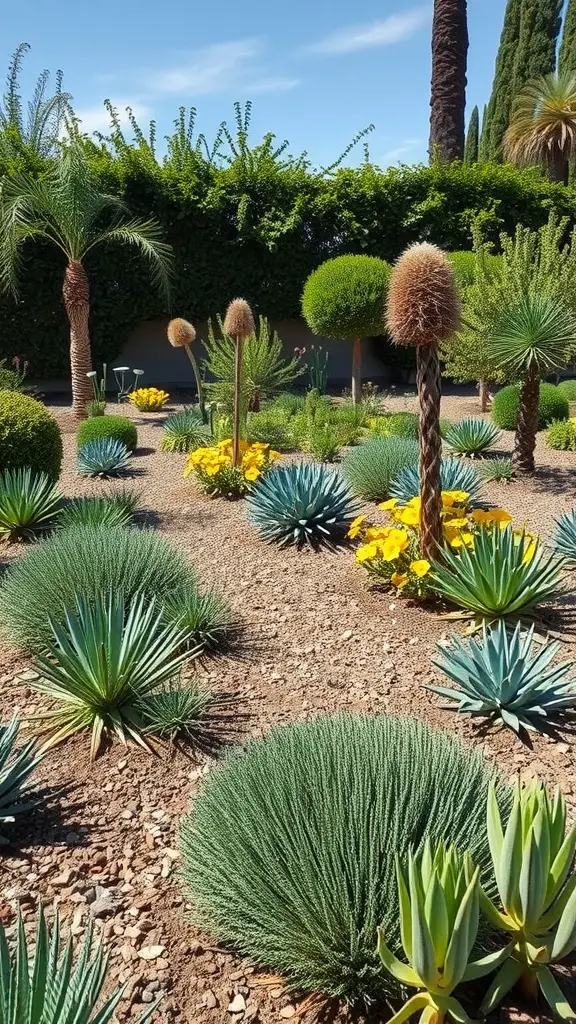
In the world of garden design, choosing drought-tolerant plants can make all the difference. The image showcases a beautiful garden filled with these resilient plants. Here, you can see various types of succulents and other drought-resistant flora, arranged thoughtfully to create a visually appealing landscape.
The mix of textures and colors adds a lively touch to the garden. Notice the spiky forms of the agave plants and the round shapes of other succulents. These plants not only save water but also require minimal maintenance, making them ideal for anyone looking to create a sustainable garden.
Incorporating bright yellow flowers among the greenery brings a cheerful vibe, proving that drought-tolerant plants can be just as vibrant and eye-catching as traditional garden plants. By selecting these hardy beauties, you’re contributing to a more eco-friendly environment while still enjoying the aesthetic appeal of your garden.
When planning your garden, consider grouping plants with similar water needs. This approach not only makes watering easier but also ensures that your garden thrives in dry conditions. So, let’s embrace the beauty of drought-tolerant plants and create a sustainable outdoor space that you’ll love!
Wildlife-Friendly Formal Gardens
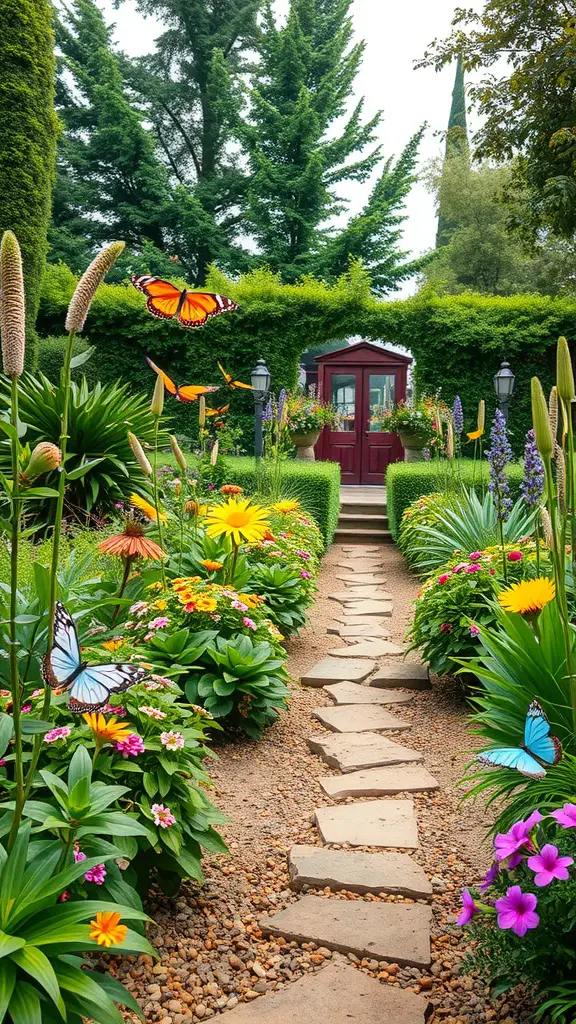
Creating a wildlife-friendly formal garden is a delightful way to blend design with nature. The image showcases a beautifully structured garden path, lined with vibrant flowers and fluttering butterflies. This setting not only serves human aesthetics but also invites various creatures to thrive.
The garden path is made of stone, leading visitors through a colorful array of plants. Flowers like daisies and zinnias attract butterflies and bees, adding movement and life to the space. The carefully trimmed hedges provide a natural habitat for small birds and insects, making the garden feel alive.
Incorporating natural elements is key in these gardens. By choosing native plants, you can ensure that local wildlife finds food and shelter. The use of non-toxic pest control methods can also help maintain a healthy ecosystem. This approach not only supports wildlife but enhances the overall beauty of the garden.
Visitors to this garden can enjoy quiet moments, listening to the sounds of nature along the path. Adding features like birdbaths or small water sources can further attract wildlife, creating a peaceful, harmonious environment. Ultimately, a wildlife-friendly formal garden fosters a connection between nature and people, enriching the gardening experience.
The Importance of Soil Quality in Design
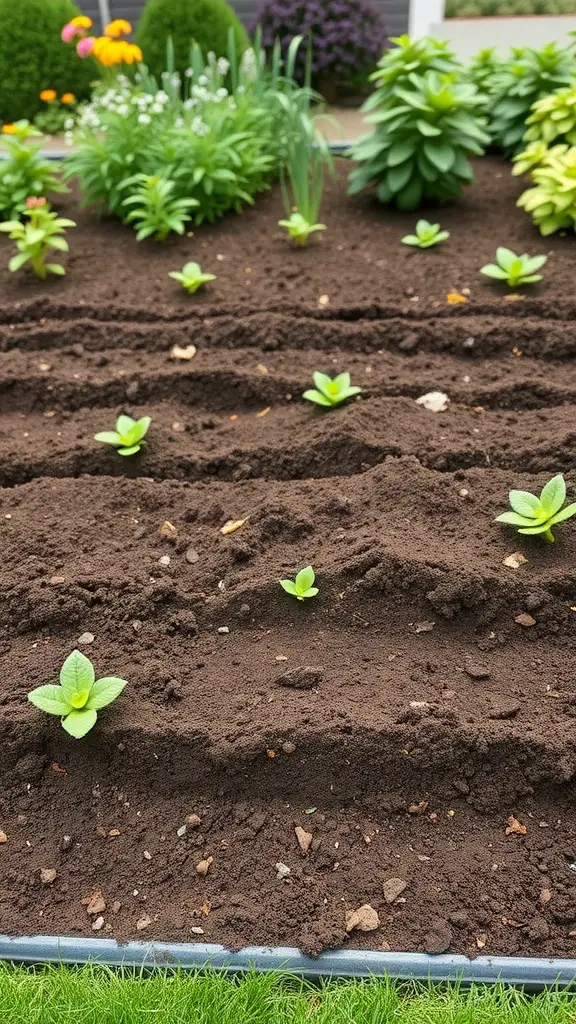
In any formal garden design, soil quality plays a crucial role. Looking at the image, you can see well-prepared rows of soil where young plants are beginning to take root. This careful arrangement shows how thoughtful planning can enhance the growth of plants.
Good soil is not just dirt; it’s a living ecosystem. The rich, dark color of the soil in the image indicates it is fertile and likely contains a variety of organic matter. This organic content is essential for retaining moisture and providing nutrients to the plants.
When designing a garden, assessing the soil is a must. Checking for drainage, nutrient levels, and pH can determine which plants will thrive in your space. As seen in the rows of young plants, giving them the right start in nutrient-rich soil can lead to a vibrant garden.
Additionally, the layout of the garden in the image demonstrates how soil preparation can impact plant growth. By creating raised rows, gardeners can improve drainage and ensure each plant has space to grow without competition for resources. This method is especially helpful in formal gardens where aesthetics and plant health are both priorities.
Using Color Theory in Plant Selection

Color theory plays an important role in garden design, especially when selecting plants. In the image, we see a vibrant mix of flowers and foliage that creates a cheerful atmosphere. The use of various colors not only draws the eye but also influences the mood of the space.
For instance, the deep blues of the delphiniums contrast beautifully with the bright pink dahlias, creating a striking visual appeal. Pairing cool colors like blue and purple with warm colors such as red and yellow can create a balanced look, making the garden feel inviting and harmonious.
Consider choosing plants that bloom at different times to ensure a continuous display of color throughout the season. This approach not only enhances the overall aesthetic but also provides a dynamic experience for anyone wandering through the space. Remember, the right color combinations can evoke emotions and create a sense of tranquility or excitement.
Overall, using color theory in plant selection can transform a garden into a delightful retreat. So, don’t shy away from experimenting with different shades and arrangements to create your ideal outdoor space!
Creating Focal Points: Enhancing Visual Interest
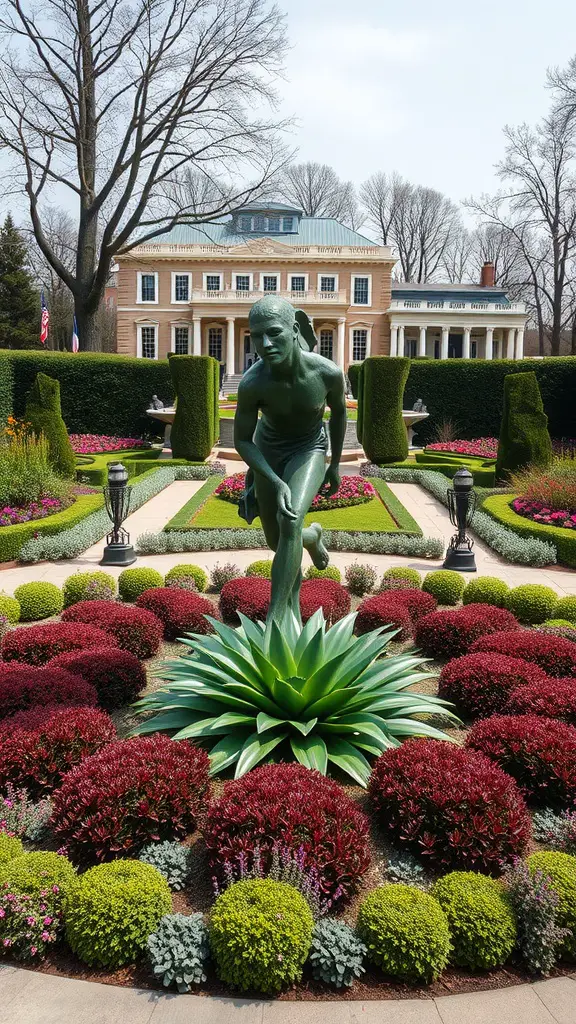
In the realm of formal garden design, creating focal points is essential for enhancing visual interest. The image showcased here illustrates a beautifully arranged garden with a striking sculpture at its center. This statue not only draws the eye but also serves as a conversation starter, inviting visitors to explore the surrounding landscape.
The vibrant colors of the flowers and carefully trimmed hedges complement the statue, making it stand out even more. Surrounding the focal point are rich textures and varying heights, which add depth to the garden. The contrasting greens and reds create a harmonious palette that feels inviting and dynamic.
Incorporating elements like this sculpture can transform a simple garden into a captivating space. Think about how different materials and plant choices can work together to guide the viewer’s attention. The overall arrangement encourages wandering and discovery, making each visit to the garden a new experience.
Incorporating Pathside Seating for Relaxation
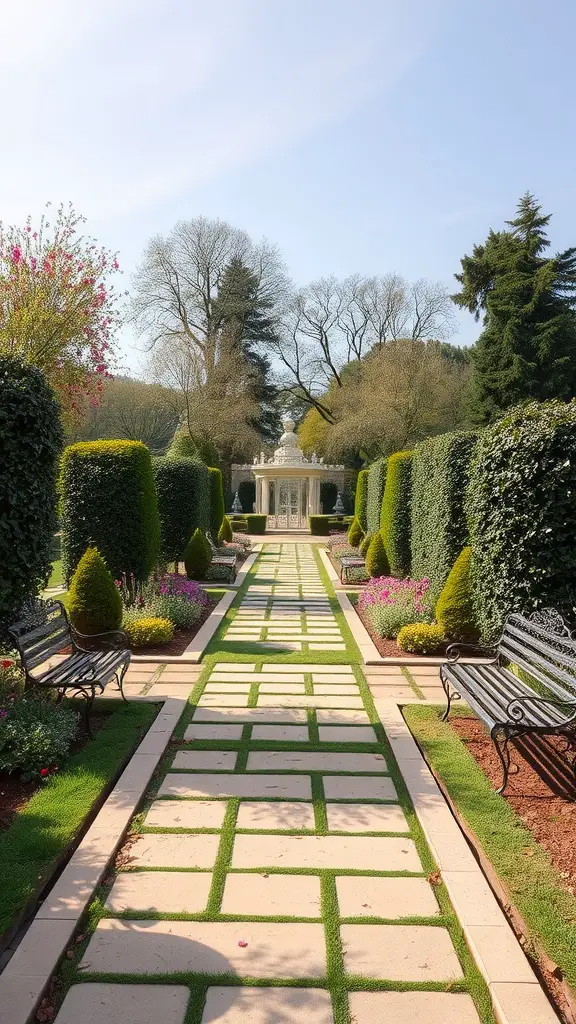
Incorporating pathside seating in a formal garden design not only enhances the aesthetic appeal but also offers a delightful spot for relaxation. Imagine walking down a beautifully paved path, flanked by neatly trimmed hedges and colorful flowers, with inviting benches along the way. This setup encourages guests to pause, take in the beauty, and enjoy the tranquility of nature.
The image above illustrates this concept perfectly. The benches are strategically placed, providing ideal spots to sit and soak in the surroundings. The lush greenery and vibrant blooms create a calming atmosphere, making it a great place to unwind. The thoughtful layout of the path, combined with the seating, invites visitors to explore, linger, and appreciate the garden’s beauty.
When planning pathside seating, consider the materials and styles that blend with the overall theme of the garden. Classic wrought iron benches, like those shown in the image, can add a touch of elegance while offering comfort. Additionally, placing these benches near blooming flowers allows guests to enjoy the delightful fragrances and sights, creating a truly immersive experience.
Cultural Influences in Formal Garden Design
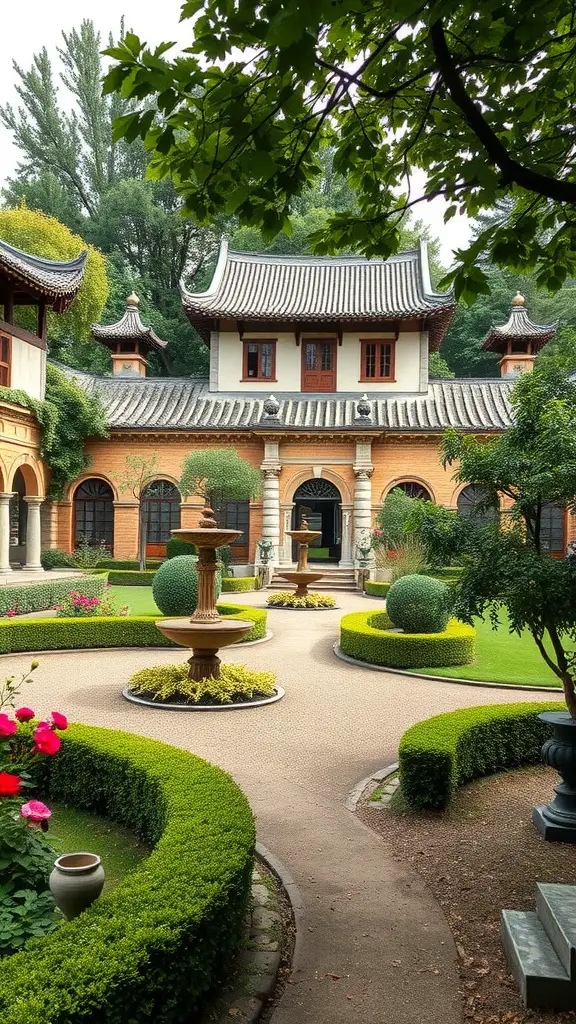
Formal garden design often reflects a rich tapestry of cultural influences. The image above showcases a stunning formal garden, which beautifully integrates architectural elements with carefully manicured landscapes. The symmetry and structure speak to a deep appreciation for order and aesthetics prevalent in many cultures.
In this garden, traditional Asian architecture features prominently, showcasing a blend of elegance and functionality. The rooftops with their distinctive curves and the use of natural materials highlight how architecture and garden design can harmoniously coexist.
The layout of the garden is equally impressive. It combines geometric shapes with organic elements, emphasizing the balance between nature and human creativity. The circular paths and trimmed hedges guide visitors through the space, making the experience both organized and inviting.
Additionally, the inclusion of water features, like the fountains seen here, reflects a common theme in many formal gardens across cultures. They often symbolize purity and tranquility, enhancing the overall atmosphere. This blend of cultural motifs and design philosophies invites us to appreciate the beauty of nature while also respecting diverse cultural heritages.
Innovative Use of Space in Small Formal Gardens
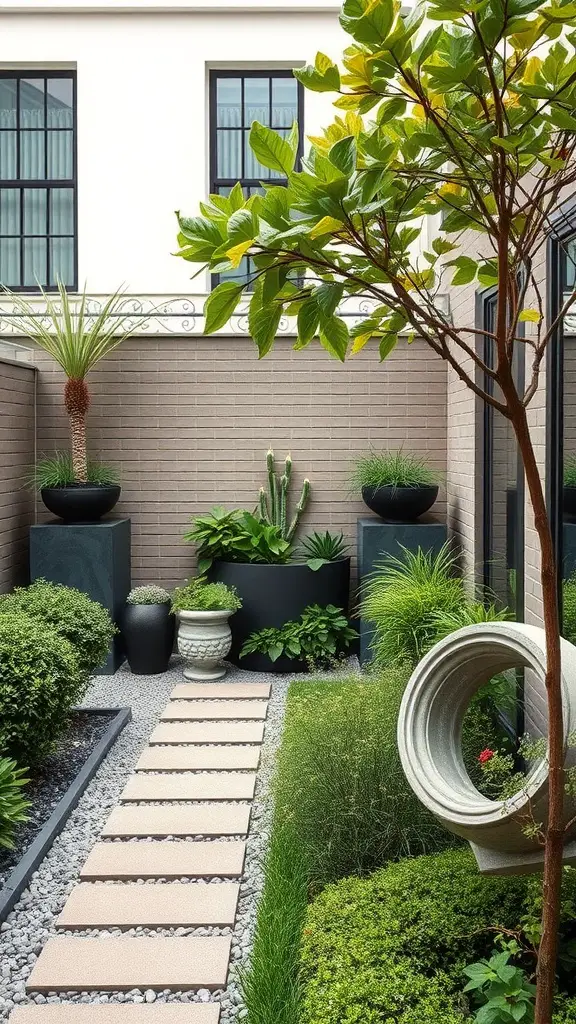
Small formal gardens can be a challenge, but they also offer unique opportunities for creativity. The image shows a beautifully designed space that makes the most of limited square footage. You’ll notice that the layout incorporates various elements, ensuring the garden feels both open and inviting.
The pathway made of well-placed stepping stones leads the eye through the space, creating a sense of flow. This design choice encourages exploration, inviting you to wander and discover different areas. The use of gravel around the stones adds texture and breaks up the greenery effectively.
Plant selection plays a crucial role, too. In the image, tall plants contrast nicely with shorter ones, bringing depth and interest. The combination of potted plants and ground cover creates a layered look, enhancing visual appeal without overwhelming the small area. The minimalistic pots complement the overall formal style while adding a modern touch.
Incorporating art pieces, like the sculptural element seen in the corner, adds personality. It serves as a focal point that draws attention and makes the garden feel more curated. There’s a balance between structure and nature, showcasing how small spaces can still feel sophisticated.
Formal Garden Maintenance: Keeping It Pristine
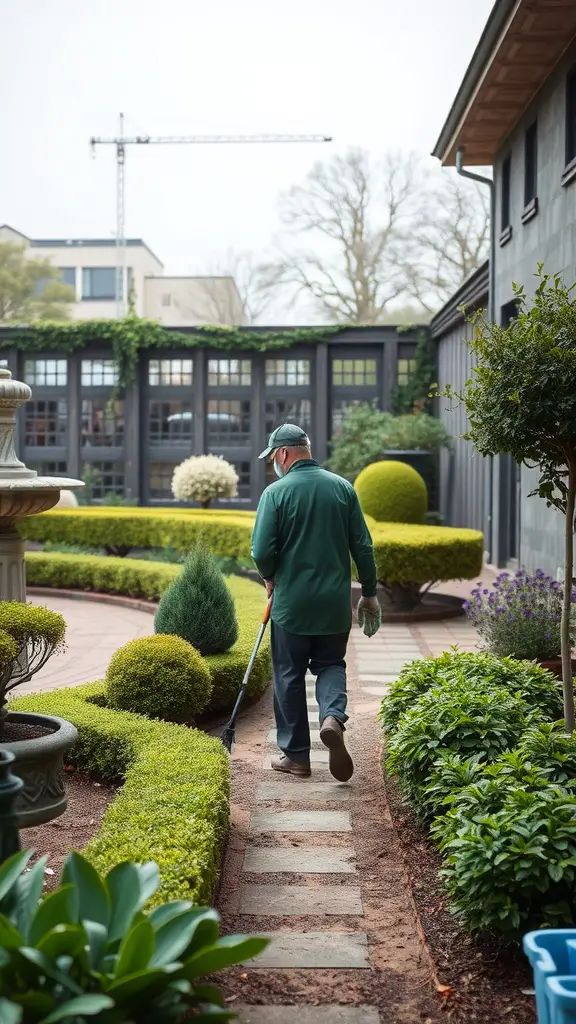
Maintaining a formal garden is all about attention to detail. In the image, we see a gardener diligently working to keep the garden well-groomed. His careful approach showcases the importance of regular upkeep in these structured spaces.
Formal gardens are known for their clean lines, symmetrical designs, and manicured plants. The rounded shrubs and neatly trimmed hedges in the background highlight the effort put into creating a polished look. This level of maintenance ensures that every corner of the garden remains visually appealing.
Regular maintenance tasks include pruning, weeding, and edging. The gardener in the image appears to be focused on one of these tasks, which is essential for preserving the garden’s formal aesthetic. Keeping pathways clear and ensuring that plants are healthy is part of the routine.
The environment around the gardener also plays a role in garden maintenance. The structures in the background suggest an organized space, which complements the garden’s design. This harmony between the garden and its surroundings adds to the overall beauty.
In summary, maintaining a formal garden requires dedication and a keen eye. With the right care, these gardens can provide a charming and inviting atmosphere for everyone to enjoy.
Symmetrical Plant Arrangements and Pathways
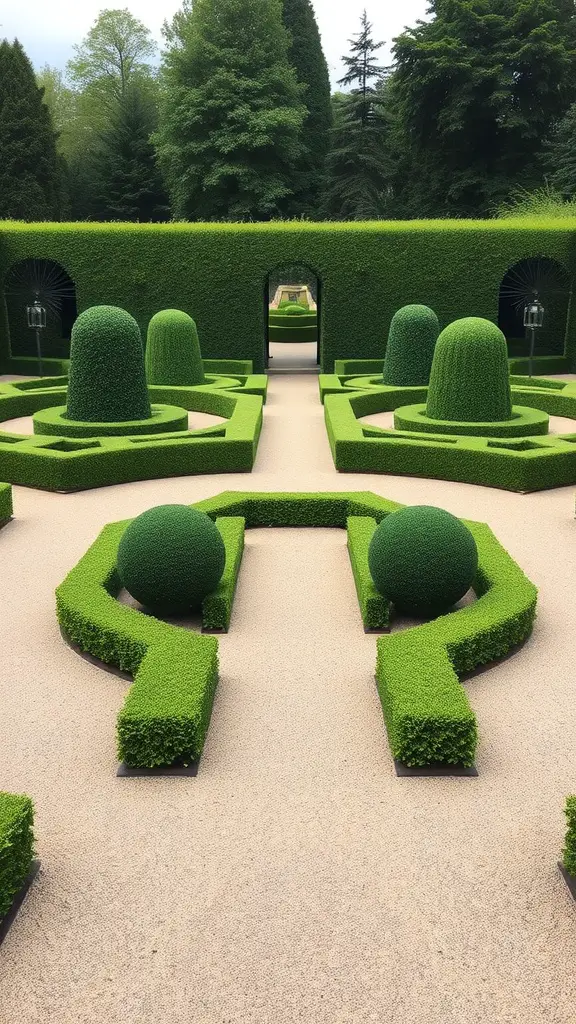
In a formal garden, symmetry plays a key role in creating a balanced and harmonious environment. The image showcases a beautifully arranged garden featuring neatly trimmed hedges and geometric shapes. These elements draw the eye and provide structure, making the space feel both organized and inviting.
The pathways in the garden are designed to enhance the flow of movement, allowing visitors to stroll through the greenery effortlessly. Each pathway leads to a unique focal point, encouraging exploration and appreciation of the plants. The use of circular and rectangular shapes adds to the overall harmony of the garden.
Every detail matters in this type of design. The lush green shrubs are perfectly shaped, and their uniform height contributes to the sense of order. This not only makes for a visually appealing scene but also creates a sense of tranquility. Gardens like this often serve as a retreat from the chaos of everyday life, allowing you to pause and enjoy the beauty around you.
When designing your own formal garden, consider incorporating similar symmetrical arrangements and pathways. This will not only elevate the aesthetic but also offer a peaceful space for relaxation and contemplation. A well-thought-out layout can make all the difference in how you experience your garden.
Sustainable Practices for Modern Formal Gardens
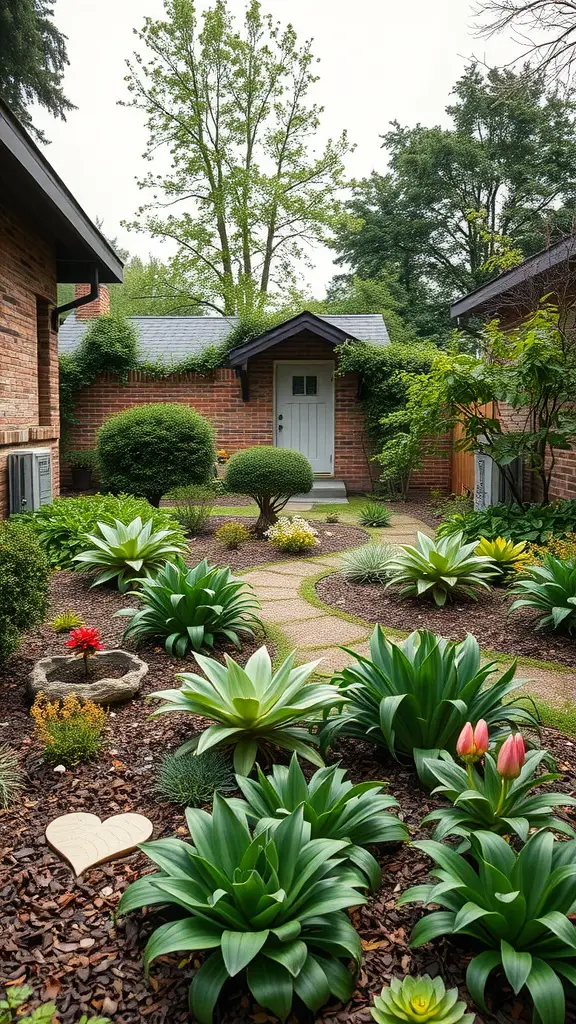
In a world where sustainability is becoming increasingly important, modern formal gardens can still shine while being eco-friendly. The image above showcases a lovely garden that marries aesthetics with environmental consciousness.
At first glance, the garden presents a harmonious blend of structured pathways and vibrant plant life. The neat layout encourages visitors to stroll and explore, while the choice of low-maintenance plants reduces the need for excessive resources.
Using native plants is a key sustainable practice. These plants are adapted to the local climate and require less water and care. Notice in the image how the lush greenery surrounds the pathway, creating visual interest without demanding too much upkeep.
Additionally, the garden features natural mulch, which not only maintains soil moisture but also suppresses weeds. This practice minimizes the need for chemical herbicides, promoting a healthier ecosystem.
Incorporating elements like rainwater collection systems can also enhance sustainability. By capturing and using rainwater, gardeners can reduce their reliance on municipal water supplies. It’s a simple yet effective way to make any garden more resilient.
Finally, consider the use of organic fertilizers. These enrich the soil without the harmful effects of synthetic options. Just like the garden in the image, a mix of careful planning and sustainable practices can lead to a beautiful and environmentally-friendly outdoor space.




